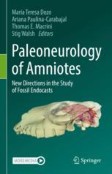Search
Search Results
-
Morphological disparity and structural performance of the dromaeosaurid skull informs ecology and evolutionary history
Non-avialan theropod dinosaurs had diverse ecologies and varied skull morphologies. Previous studies of theropod cranial morphology mostly focused on...

-
A non-avian dinosaur with a streamlined body exhibits potential adaptations for swimming
Streamlining a body is a major adaptation for aquatic animals to move efficiently in the water. Whereas diving birds are well known to have...

-
Decoupling the skull and skeleton in a Cretaceous bird with unique appendicular morphologies
The Cretaceous is a critical time interval that encompasses explosive diversifications of terrestrial vertebrates, particularly the period when the...

-
Avialan-like brain morphology in Sinovenator (Troodontidae, Theropoda)
Many modifications to the skull and brain anatomy occurred along the lineage encompassing non-avialan theropod dinosaurs and modern birds. Anatomical...

-

-
Avian Locomotion: Flying, Running, Walking, Climbing, Swimming, and Diving
Most birds can fly, but can also, to varying degrees depending on the species and their habitats, walk, run, climb, swim, and dive. With a focus on...
-

-
Deep reptilian evolutionary roots of a major avian respiratory adaptation
Vertebral ribs of the anterior thorax in extant birds bear bony prongs called uncinate processes, which improve the mechanical advantage of mm....

-
Feather Evolution in Pennaraptora
Two decades of paleontological discoveries of basal birds and non-avian theropods with preserved integumentary structures, especially in Late...
-
Archaeopteryx feather sheaths reveal sequential center-out flight-related molting strategy
Modern flying birds molt to replace old and worn feathers that inhibit flight performance, but its origins are unclear. We address this by presenting...

-
Shed teeth from Portezuelo formation at Sierra del Portezuelo reveal a higher diversity of predator theropods during Turonian-Coniacian times in northern Patagonia
The study of thirty-two shed crowns from the Portezuelo Formation (middle Turonian-late Coniacian) at the Sierra del Portezuelo locality, reveals six...

-
A titanosaurian sauropod with Gondwanan affinities in the latest Cretaceous of Europe
The origin of the last sauropod dinosaur communities in Europe and their evolution during the final 15 million years of the Cretaceous have become a...

-
The Plumage of Basal Birds
Early bird plumage is well known primarily due to numerous discoveries of specimens preserving feathers from Early Cretaceous deposits in China....
-
Filamentous Integuments in Nonavialan Theropods and Their Kin: Advances and Future Perspectives for Understanding the Evolution of Feathers
The discovery of Sinosauropteryx in 1996 marks the beginning of a new era in the research on the origin and early evolution of feathers. Subsequent...
-
The Origin of Birds: Current Consensus, Controversy, and the Occurrence of Feathers
Research in the late 1900s has established that birds are theropod dinosaurs, with the discovery of feather preservation in non-avian theropods being...
-
Integument
The skin of birds keeps out pathogens and other potentially harmful substances, retains vital fluids and gases, serves as a sensory organ, and...
-
Origin and Evolution of Birds
Archaeopteryx lived about 155 million years ago and was a descendent of a long line of dinosaur and theropod ancestors. In this chapter, I review...
-
Paleoneurology of Non-avian Dinosaurs: An Overview
This chapter aims to provide an overview of the state of knowledge on non-avian dinosaur paleoneurology, throughout the history and synthesis of...
-
Convergent Evolution of Manual and Pedal Gras** Capabilities in Tetrapods
Gras** behavior and manipulation using the hand and/or foot is widespread among tetrapods and can be used in various contexts in the daily life of...
-
Integumentary Structures in Kulindadromeus zabaikalicus, a Basal Neornithischian Dinosaur from the Jurassic of Siberia
Recent studies on the origin of feathers have been stimulated by discoveries of feather-like structures in various nonavian theropod dinosaurs from...
